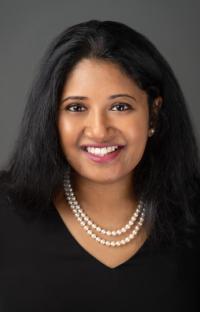Dr. Pallavi Utukuri’s Virtual Autopsy Project
When it comes to teaching radiology to medical students, educators agree on one thing: Imaging should be taught earlier and more comprehensively in medical school. But the rotation model of medical student education—where students concentrate on subspecialties by taking electives during their final years of medical school—confines radiology education to a four-week course that not all medical students take.
“Imaging is everywhere in medicine and the students don't even realize the scope and the breadth of it until their fourth-year elective,” says Dr. Pallavi Utukuri, director of medical student education in the Department of Radiology at Columbia University Irving Medical Center (CUIMC). "Radiology is such a significant part of medicine that it needs to be in the curriculum at a much earlier stage.”
A 2014 survey of the US medical school system by the American College of Radiology (ACR) and the Alliance of Medical Student Educators in Radiology (AMSER) came to a similar conclusion. “The importance of medical imaging to patient care has grown exponentially,” the authors concluded. “However, the role of radiology in teaching has not changed in a correlative fashion.”
At Columbia’s Vagelos College of Physicians and Surgeons, Dr. Utukuri, assistant professor and director of radiology at NewYork-Presbyterian Allen Hospital, is meeting this challenge head on. In her short tenure here, Dr. Utukuri has transformed the way her specialty is taught at Columbia.
Dr. Utukuri came to Columbia in 2010 and took on the role of medical student education director a few years later. Her first task, as she saw it, was structuring the four-week radiology elective, which many medical students take in their third or fourth year. She set clear goals and expectations for the students. “These are future doctors and they're going to order tests. There's a pretty huge knowledge gap in how to do it properly,” she says. “Fifty percent of the elective curriculum is now imaging appropriateness and they really seem to like it.”
As she was organizing the department’s core offering to medical students, Dr. Utukuri saw opportunities to integrate radiology into the medical school curriculum at a much earlier stage.
Gross anatomy is among the first courses that medical students take at Columbia’s Vagelos College of Physicians and Surgeons; working in groups of four, they learn anatomy by dissecting cadavers. Until recently, course lectures sometimes involved X-rays and CT scans, but radiology was peripheral to the curriculum, and it was not taught by radiologists. Dr. Utukuri had questions. How could the students get to hear from the actual imagers? How could this quintessential course address the impact of imaging? How could she help make it fun and engaging for these young learners?
After attending a presentation about how imaging is used in homicide cases, Dr. Utukuri’s virtual autopsy project was born. “In Europe, if there is a suspicious death, they actually do imaging on the homicide victim.”
Under the guidance of her mentor, Joshua Weintraub, MD, executive vice chair of radiology, Dr. Utukuri took her idea to Dr. Paulette Bernd, the course director. “What if we scanned the individual cadavers?” Students would see something on the CT scan and then do the work to find out what they were seeing. “What we came up with was, let’s have the students treat this like their very first patient with a diagnostic dilemma,” she says.
There are limitations to scanning a cadaver, such as the lack of IV contrast and artifacts that show up from the embalming process. Nevertheless, Dr. Utukuri says that interesting things frequently pop up. “For these first-year students, even to find a pacemaker on CT, or a prosthetic arm, it's very interesting. Before they make their first incision, they know what to expect.”
Using information from the CT scan, the students become detectives. “If you see a lung mass, you know what it looks like on CT, you know what it looks like in real life, and you get slides of it. You use all that information and you think about what may have led to this patient's death.”
The virtual autopsy project will enter its third year this September and it has been a huge success—well worth the effort it takes to scan 30 cadavers on a weekend morning. Medical students, radiology residents, faculty and techs give up their time to participate in the scanning, which involves a truck and a fair amount of physical labor. “It's a bonding experience for the students, the anatomy faculty, and radiology,” says Dr. Utukuri.
One of the more gratifying consequences of the project has been that students get a close look at the specialty early on in their education. Moreover, for some of them, it has a direct impact on their choice of radiology as their specialty.
Dr. Utukuri is already at work on her next big idea for education: a hybrid-learning classroom for the radiology elective, where lectures happen online and classroom time is used for case-based discussions. She recently received the Hybrid Learning Course Redesign and Delivery grant from the Office of the Provost at Columbia University to develop this project. “It’s the way of the future,” she says.


